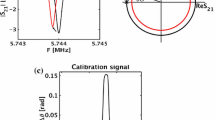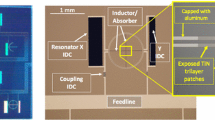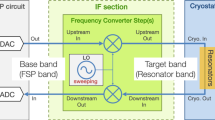Abstract
Microwave Kinetic Inductance Detectors (MKIDs) are highly scalable detectors that have demonstrated nearly background-limited sensitivity in the far-infrared from high-altitude balloon-borne telescopes and space-like laboratory environments. In addition, the detectors have a rich design space with many optimizable parameters, allowing high sensitivity measurements over a wide dynamic range. For these reasons, MKIDs were chosen for the Experiment for Cryogenic Large-Aperture Intensity Mapping (EXCLAIM), a balloon-borne telescope targeting nearly background-limited performance in a high-altitude atmospheric environment from 420 to 540 GHz. We describe MKID optimization in the specific context of EXCLAIM and provide general results that apply to broader applications. Extending the established approach of tone frequency tracking, we show that readout power optimization enables significant, further improvement in dynamic range.


Similar content being viewed by others
References
J. Baselmans, J. Bueno, S.J. Yates, O. Yurduseven, N. Llombart, K. Karatsu, A. Baryshev, L. Ferrari, A. Endo, D. Thoen et al., A kilo-pixel imaging system for future space based far-infrared observatories using microwave kinetic inductance detectors. Astron. Astrophys. 601, A89 (2017)
C.M. Bradford, B.A. Cameron, B.D. Moore, S. Hailey-Dunsheath, E.G. Amatucci, D.C. Bradley, J.A. Corsetti, D.T. Leisawitz, M.J. DiPirro, J.G. Tuttle et al., Origins survey spectrometer: revealing the hearts of distant galaxies and forming planetary systems with far-ir spectroscopy. J. Astron. Telescopes Instrum. Syst. 7(1), 011017 (2021)
C. Carilli, F. Walter, Cool gas in high-redshift galaxies. Ann. Rev. Astron. Astrophys. 51, 105–161 (2013)
G. Cataldo, P. A. Ade, C. J. Anderson, A. Barlis, E. M. Barrentine, N. G. Bellis, A. D. Bolatto, P. C. Breysse, B. T. Bulcha, J. A. Connors, et al., Overview and status of exclaim,the experiment for cryogenic large-aperture intensity mapping. In Ground-based and Airborne Telescopes VIII, 11445, 1144524. International Society for Optics and Photonics, 2020
J.-J. Chang, D. Scalapino, Nonequilibrium superconductivity. J. Low Temp. Phys. 31(1), 1–32 (1978)
P.K. Day, H.G. LeDuc, B.A. Mazin, A. Vayonakis, J. Zmuidzinas, A broadband superconducting detector suitable for use in large arrays. Nature 425(6960), 817–821 (2003)
D. Flanigan, B.R. Johnson, M.H. Abitbol, S. Bryan, R. Cantor, P. Day, G. Jones, P. Mauskopf, H. McCarrick, A. Miller et al., Magnetic field dependence of the internal quality factor and noise performance of lumped-element kinetic inductance detectors. Appl. Phys. Lett. 109(14), 143503 (2016)
J. Gao. The physics of superconducting microwave resonators. PhD thesis, California Institute of Technology, 2008. http://thesis.library.caltech.edu/2530
J. Glenn, C.M. Bradford, E. Rosolowsky, R. Amini, K. Alatalo, L. Armus, A.J. Benson, T.-C. Chang, J. Darling, P.K. Day et al., Galaxy evolution probe. J. Astron. Telescopes Instrum. Syst. 7(3), 034004 (2021)
D. Goldie, S. Withington, Non-equilibrium superconductivity in quantum-sensing superconducting resonators. Supercond. Sci. Technol. 26(1), 015004 (2012)
S. Gordon, A. Sinclair, P. Mauskopf, G. Coppi, M. Devlin, B. Dober, L. Fissel, N. Galitzki, J. Gao, J. Hubmayr et al., Preflight detector characterization of blast-tng. J. Low Temp. Phys. 200(5), 400–406 (2020)
T. Guruswamy, D. Goldie, S. Withington, Quasiparticle generation efficiency in superconducting thin films. Supercond. Sci. Technol. 27(5), 055012 (2014)
J. R. Hoh, A. Sinclair, R. Stephenson., Maximizing dynamic range of microwave kinetic inductance detectors through high-speed tone tracking. In J. Zmuidzinas and J.-R. Gao, editors, Millimeter, Submillimeter, and Far-Infrared Detectors and Instrumentation for Astronomy X, volume 11453. (International Society for Optics and Photonics, SPIE, 2020) https://doi.org/10.1117/12.2559899
E. D. Kovetz, M. P. Viero, A. Lidz, L. Newburgh, M. Rahman, E. Switzer, M. Kamionkowski, J. Aguirre, M. Alvarez, J. Bock, et al. Line-intensity mapping: 2017 status report. arXiv preprintarXiv:1709.09066, 2017
A. Kozorezov, A. Volkov, J. Wigmore, A. Peacock, A. Poelaert, R. Den Hartog, Quasiparticle-phonon downconversion in nonequilibrium superconductors. Phys. Rev. B 61(17), 11807 (2000)
D. Leisawitz, E. G. Amatucci, L. N. Allen, J. W. Arenberg, L. Armus, C. Battersby, J. M. Bauer, P. Beltran, D. J. Benford, D. Burgarella, et al. (2021) Origins space telescope: baseline mission concept. J. Astron. Telescopes Instrum. Syst. 7(1)
A. Lowitz, E. Barrentine, S. Golwala, P. Timbie, A comparison of fundamental noise in kinetic inductance detectors and transition edge sensors for millimeter-wave applications. J. Low Temp. Phys. 176(3), 504–510 (2014)
S. Masi, P. De Bernardis, A. Paiella, F. Piacentini, L. Lamagna, A. Coppolecchia, P. Ade, E. Battistelli, M. Castellano, I. Colantoni et al., Kinetic inductance detectors for the olimpo experiment: in-flight operation and performance. J. Cosmol. Astropart. Phys. 2019(07), 003 (2019)
P. Mauskopf, Transition edge sensors and kinetic inductance detectors in astronomical instruments. Publ. Astron. Soc. Pac. 130(990), 082001 (2018)
M. Mirzaei, E. M. Barrentine, B. T. Bulcha, G. Cataldo, J. A. Connors, N. Ehsan, T. M. Essinger-Hileman, L. A. Hess, S. H. Moseley, J. W. Mugge-Durum, et al. \(\mu\)-spec spectrometers for the exclaim instrument. In Millimeter, Submillimeter, and Far-Infrared Detectors and Instrumentation for Astronomy X, Vol 11453, (International Society for Optics and Photonics, 2020)
R. Stephenson. paper in preparation
L. Swenson, P. Day, B. Eom, H. Leduc, N. Llombart, C. McKenney, O. Noroozian, J. Zmuidzinas, Operation of a titanium nitride superconducting microresonator detector in the nonlinear regime. J. Appl. Phys. 113(10), 104501 (2013)
E.R. Switzer, E.M. Barrentine, G. Cataldo, T. Essinger-Hileman, P.A. Ade, C.J. Anderson, A. Barlis, J. Beeman, N. Bellis, A.D. Bolatto et al., Experiment for cryogenic large-aperture intensity mapping: instrument design. J. Astron. Telescopes Instrum. Syst. 7(4), 044004 (2021)
G. Ulbricht, M. De Lucia, E. Baldwin, Applications for microwave kinetic induction detectors in advanced instrumentation. Appl. Sci. 11(6), 2671 (2021)
J. van Rantwijk, M. Grim, D. van Loon, S. Yates, A. Baryshev, J. Baselmans, Multiplexed readout for 1000-pixel arrays of microwave kinetic inductance detectors. IEEE Trans. Microw. Theory Tech. 64(6), 1876–1883 (2016)
J. Zmuidzinas, Thermal noise and correlations in photon detection. Appl. Opt. 42(25), 4989–5008 (2003)
J. Zmuidzinas, Superconducting microresonators: Physics and applications. Annu. Rev. Condens. Matter Phys. 3(1), 169–214 (2012)
Acknowledgements
This work was supported by a 5-year NASA Astrophysics Research and Analysis (APRA 17-APRA17-0077) grant and NASA-Goddard Internal Research and Development funds, and TMO acknowledges support from the NASA-Goddard internship program and the UW-Madison graduate program.
Author information
Authors and Affiliations
Corresponding author
Additional information
Publisher's Note
Springer Nature remains neutral with regard to jurisdictional claims in published maps and institutional affiliations.
Rights and permissions
About this article
Cite this article
Oxholm, T.M., Switzer, E.R., Barrentine, E.M. et al. Operational Optimization to Maximize Dynamic Range in EXCLAIM Microwave Kinetic Inductance Detectors. J Low Temp Phys 209, 1038–1046 (2022). https://doi.org/10.1007/s10909-022-02760-6
Received:
Accepted:
Published:
Issue Date:
DOI: https://doi.org/10.1007/s10909-022-02760-6




